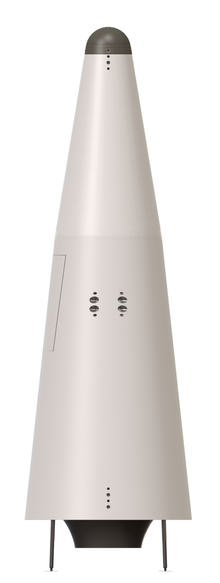

This article needs additional citations for verification. Please help improve this articlebyadding citations to reliable sources. Unsourced material may be challenged and removed.
Find sources: "CORONA" rocket – news · newspapers · books · scholar · JSTOR (August 2019) (Learn how and when to remove this message) |
You can help expand this article with text translated from the corresponding article in Russian. (September 2020) Click [show] for important translation instructions. Content in this edit is translated from the existing Russian Wikipedia article at [[:ru:Корона (ракета-носитель)]]; see its history for attribution.{{Translated|ru|Корона (ракета-носитель)}} to the talk page. |

CORONA (RLV) concept
| |
| Function | Reusable launch vehicle |
|---|---|
| Manufacturer | Makeyev Rocket Design Bureau |
| Country of origin | Russia |
| Size | |
| Height | 30 m (98 ft) |
| Diameter | 10 m (33 ft) |
| Mass | 280–290 t (620,000–640,000 lb) |
| Stages | 1 |
| Capacity | |
| Payload to LEO[altitude and inclination needed] | |
| Altitude | 200–500 km (120–310 mi) |
| Mass | 7–12 tonnes (15,000–26,000 lb) |
| Launch history | |
| Status | Under development |
| Single stage | |
| Propellant | LOX/LH2 |
CORONA is a single-stage-to-orbit launch vehicle capable of performing vertical takeoff and landing.[1] It was developed by OAO GRTs Makeyev from 1992 to 2012. However, the development was declined due to lack of funding.[2] In 2016, the company announced plans to resume the development of the CORONA vehicle.[3]
CORONA is intended for launching payloads to low Earth orbit with an altitude of 200–500 km (120–310 mi). It has a launch mass of 280–290 tonnes (620,000–640,000 lb) and is intended for launching payloads weighing up to 7 tonnes (15,000 lb) with traditional use or up to 12 tonnes (26,000 lb) with a special scheme for launching into low Earth orbit. However, the payload capacity goes down to 6 tonnes (13,000 lb) and up to 11 tonnes (24,000 lb) respectively when launching from Russia. With the use of reusable boosters that form a launch complex with it, the launch vehicle provides launching into orbits with an inclination of up to 110° up to altitudes of 10,000 km (6,200 mi) and returning from them if necessary.[4]
This rocketry article is a stub. You can help Wikipedia by expanding it. |
|
| |||||||||||||||
|---|---|---|---|---|---|---|---|---|---|---|---|---|---|---|---|
| |||||||||||||||
| |||||||||||||||
| |||||||||||||||